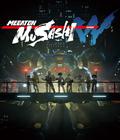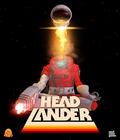Buy Headlander
Double Fine develops some pretty straightforward games with intriguing concepts. Brutal Legend, Costume Quest, and Stacking all qualify in this regard. Adult Swim Games often does the same with titles like Duck Game, Jazzpunk and Super House of Dead Ninjas to its publishing credit. By joining forces in Headlander, the duo has surprisingly not created something completely outrageous. What they do have, however, is a solid adventure title.
Playing as a nameless man or woman, you wake up from a deep sleep far into a future as envisioned by 1970s sci-fi. The minute you gain consciousness, you get a radio signal from a friend named Earl who informs you of what's going on. First, you are the last human left in the universe, and almost everyone else has opted to transfer their brains into robot bodies. Second, an intelligent supercomputer named Methuselah wants to see you either captured or dead. Finally, your own body is gone, as you're now nothing more than a head in a rocket-powered helmet. After leaving the ship, you make your way to a space station in order to find Methuselah and get some answers.
It's refreshing to see a game set in a future that isn't apocalyptic or close to being ruined. By taking '70s sci-fi as the base, the world looks pretty clean so long as you're willing to take some of the conventions of the time period's outlook on the future. You'll see robots with pointy limbs and very round heads with speakers for mouths. There's the constant use of three color tones as accents for otherwise stark white environments. Shag carpeting lives on past its expiration date. It's a quaint but refreshing take on the future, and it certainly gives the game some character from the get-go.
The opening level gives you an idea of the game's basics. As just a head, you're pretty nimble since you can fly in any direction. You can also attach yourself to a terminal and tap in to do things like activate elevators or disable laser grids. You can't pass through doors in this state, though, and that's where the body comes into play. By using your vacuum to detach the original head from its body, you can use your own head to replace it and take over its functions. You can't jump, but you can run to open doors and roll beneath low objects. You can also attack other bots by punching them or shooting them with your gun, which has a variable firing spread that depends on whose body you take over. You can fire in any direction, but using your aiming laser reveals that you can also bank your shots to reach enemies from different angles. While you may want to aim in their general direction and fire, you'll learn that headshots are a better idea since it means you can take over another body once yours loses its durability.
What you'll quickly find out is that the game loves a chaotic shootout. The minute an enemy spots you, it shoots a flurry of laser blasts before pausing for a recharge and repeating the process. Get two or three of these bots active simultaneously, and you'll have something akin to a bullet hell shooter with platforming sensibilities instead of a spaceship. It doesn't get ridiculous enough that the screen is filled with shots, but it is fairly difficult to come out of a firefight unscathed. In a way, it makes the very idea of combat pretty exciting. Oddly enough, the boss encounters don't share this philosophy, as the combat is more traditional rather than relying on overwhelming firepower to take you down.
Once you escape the spaceship and make your way to the space station via escape pod, you'll find Headlander opening up from a typical side-scrolling adventure to more of a Metroidvania game. The world is relatively open, but various roadblocks cause you to backtrack over areas several times as you obtain whatever is needed to make further progress. Exploration is key as you move horizontally and vertically through the station, but both regular doorways and passageways can be unlocked with a good vacuum so your head can get in. You'll get increases in both health and energy for your troubles, but your most precious resource is upgrade energy, which lets you unlock new abilities like shields for your head, a boost for flying, or the chance to regenerate health when you aren't being hit.
Of the many roadblocks to your progress, the most common is the color-coded doors, and the game has an interesting way of handling that. Instead of looking for colored keys, you need the robot body whose color matches that of the doorway you're trying to get through. The colors have a hierarchy with a handy guide on screen at all times to remind you of what supersedes what. For example, grab a green body, and you'll also be able to access yellow, orange, and red doors. Later stages make this a difficult endeavor, as the body you'll need will only spawn in a location that's a good distance away from the door, but for the most part, it isn't too difficult to get the right robot body or even the right colored laser blast for the job.
As a whole, the gameplay works. The shootouts and exploration are balanced rather well, so you aren't stuck doing one thing for long stretches of time. The different zones you pass through also aren't so large that you'll feel like you're in the same area for long stretches. Because of the pace at which you get your upgrade energy, gaining new abilities is swift, and you'll get everything with enough to spare for upgrading their strengths. Headlander isn't like some other Metroidvania titles that require you to slog through long stretches before getting anywhere significant.
One part of the game that feels off are the objectives. The tasks are fine, as they make sense in the overall scheme of things and aren't annoyingly difficult. However, what will irritate some players is the number of times you have to perform the tasks. Unlike most titles, where three seems to be the magic number, this title's mantra is that more is better. Whether you're lining up satellites, robbing rooms of their energy crystals or uploading data, you repeat the tasks four to six times, with each instance being slightly different from the last. Once you notice it, the extra instances feel like ways to pad out the experience. Then again, given the game's running time for a Metroidvania-style title, the padding may have felt necessary.
Graphically, Headlander is quite impressive. The game sports loads of detail, no matter how insignificant it may be. From the depression of carpeting as you step on it to the ships flying in the windows and the laser burns present on pillars that you use as cover, no detail is left out. The animations for the bots are also good, and the expressions made by your floating head during cut scenes are hilarious. As with many games earlier this generation, the lighting and particle effects impress the most. Every source of light gives off the nice, faint glow you get if you look at the edges of a light source. The glow gives it a nice sense of vibrancy, and when you combine it with the fact that the laser trails give off lots of floating particles of their own, it's astonishing to see the game get flooded with them during a firefight and not skip a beat. The one thing that will disappoint players is the lack of graphical options that can be toggled. It's a shame since the film grain used here can be slightly annoying when you're in dark areas of the space station.
The game audio also does well. Though the sound effects aren't completely committed to the throwback aesthetic, the music certainly is. Heavy on the synthesizers, it certainly evokes the feeling of a pre-Star Wars sci-fi production that celebrates the style instead of mocking it. The voice acting is as expected from a Double Fine game. The performances match that of a good cartoon series, while the writing provides some really funny material that's both smart and cheesy. Yes, some of those lines will be repeated, so you'll hear the same mocking from doors when you pass by and the same apologies being used from turrets that are trying to blast you to bits. You might not mind the repetition, though.
In the end, Headlander is a very good adventure game for fans of the Metroidvania blueprint. The gimmicks that come from a flying head are used well, and the idea never feels tired. The action in firefights is good, and the number of areas and slightly hidden passageways in the world makes exploration equally worthwhile. It does feel like a drag whenever you have to perform the same action multiple times in different parts of a level, but the game is short enough that the padding doesn't feel too bad. Overall, genre fans will have a great time with Headlander.
Score: 8.0/10
More articles about Headlander










 Headlander is a a retro-futuristic, side-scrolling, action-adventure game set in a world inspired by '70s science fiction.
Headlander is a a retro-futuristic, side-scrolling, action-adventure game set in a world inspired by '70s science fiction.










